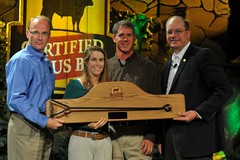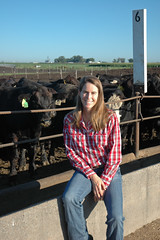My husband is an electrical engineer by training and used to build computer chips before we made the life choice to move back to Nebraska to farm. He is absolutely fascinated with electrical “gadgets”, and is celebrating his 40th birthday this week with a new “entertainment system”. The new system has at least five remote controls, and I am pretty sure that I will never bother to learn how to use any of them. As you might guess, I do not share my husband’s love of electronics. I use them on a necessity basis, and generally have a negative attitude toward them (which, of course, signals them to lock up and fail to work when I need them most…). Is the TV, computer, or blackberry phone purposely “out to get me”? Of course not! But I might, during an irrational moment of frustration, tell you otherwise…
Am I afraid and distrustful of all technology? No, I only fear and doubt the technology that I am not familiar with and have no experience using.
This is a natural human tendency…

I use a scale indicator "chute side" to weigh cattle and trace calf gain during the feeding period. This helped Al and I trace the performance of Calf #718 and leads to producing a better animal each and every year...Yeah for technology!

We "catch" our animals in a squeeze chute which allows us to safely administer vaccines, ear tags, and growth hormone implants. Here, I am administering a vaccine...The continual technical advancements of squeeze chutes improves both my physical safety when handling cattle, and also the safety of the animal and his beef because he is properly restrained during these procedures. Yeah for technology!
Growth hormones are a technology that I am completely comfortable with because I work with them every day, and I am very well educated in both the science and the practical implementation of their use. I am familiar with them, and familiarity leads to trust and confidence. Many of you may think that I am silly to harbor anxiety toward a computer or a blackberry phone while I have complete confidence with the technologies that I use at the feed yard.
Everything is relative…

Cassie Payne learned of the technology of prey animal psychology and the role that low stress handling plays in improving both the welfare and the efficiency of cattle at my feed yard when she visited last week. Here, she is learning to exercise and acclimate newly arrived cattle. Yeah for technology!
Cassie, who just finished her master’s degree in Ruminant Nutrition (cattle are ruminant animals) shared some statistics with us last week in a comment on my first hormone post. Let’s look at those numbers a little bit closer…
Testosterone in beef:
Differences in testosterone levels in the muscle of cattle (that’s the part that we eat) between hormone implanted and non-implanted steers are not statistically significant. Bull meat, however, (which comes from male cattle that have not been castrated and turned into steers) has 30 times higher levels of testosterone than either hormone implanted or non-implanted steers.
Estrogen in beef and the levels relative to some other foods:
1. Non-implanted beef: 0.16 parts per billion (nanograms/gram)
2. Implanted beef: 0.22 parts per billion
3. Milk: 0.12 parts per billion
4. Eggs: 35 parts per billion
5. Soy flour: 1,510,000 parts per billion !!
6. Female daily production: 5,000,000 nanograms
7. Male daily production: 100,000 nanograms
In a nutshell, it would require a woman to eat more than FIFTY THOUSAND POUNDS of beef from an implant treated steer PER DAY to get the same level of estrogen as natural female daily production.
The original question left to be answered by this post is, “Why do I feel good about using growth hormones?”
The first half of the answer is because I know that the beef from a hormone treated steer is safe to feed to my family.
The second half of the answer is that it reduces my environmental footprint and allows me to grow more pounds of healthy beef while using fewer natural resources. Let’s go back to Calf #718 to look at this further…

A lot of technology went into "setting #718 up for success" and making great tasting, safe, and efficiently produced beef!
The use of growth hormones in Calf #718 allowed him to gain approximately 100# more weight at the feed yard. Consequently, I was able to prepare the calf for harvest in twenty five fewer days during the finishing phase compared to a non-hormone treated steer. If you convert this to pounds of feed necessary to prepare the animal for harvest, growth hormones allowed me to finish Calf #718 with approximately 600 dry matter pounds less of feed! This significantly reduces the environmental foot print of Calf #718 which, as someone who strives for sustainable food production, is very important to me.

Sometimes learning about and using technology opens to door to great things! Did you ever think about how a feed yard could be environmentally friendly?
So, while I may never learn to use all five remote controls on my husband’s new entertainment system, I embrace the technologies that allow me to do a better job of caring for my animals and efficiently producing safe and healthy beef! Growth hormone use is one of those technologies. I invite you to check out the sources that Cassie listed for us in her comment from last week. The following is a link to Cassie’s blog site post regarding hormone use: http://foodthinkforum.blogspot.com/2011/05/going-hormonal-over-beef.html











Pingback: Hormones… | Feed Yard Foodie
So if I understand correctly, implanting artificial hormones leads the animal to increase its own production of estrogen and testosterone and you list those levels. Is there no residue of the implanted hormone in muscle tissue at slaughter?
Hi Grant. Yes, that is correct. There is no residue of the implanted hormone in the muscle tissue. If you take a look at the FDA guidelines for hormone implants you will see that they are administered just underneath the skin in the ear of the animal. The hormones in the ear cavity slowly enter the bloodstream and stimulate the pituitary gland to produce more somatotropin which is the animal’s own natural growth promoting agent. The ear of the animal is discarded at harvest (does not enter either the human or animal food chain). There is no statistically significant effect on the meat/muscle tissue itself.
Thank you for taking the time to read and to ask a great question. Please feel free to visit the home page and search the blog site for other information pertaining to how I raise cattle on my farm. I appreciate the opportunity to interact with you!
All the best,
Anne
Pingback: Environmental Sustainability: How do I care? | Feed Yard Foodie
Do you mind if I quote a few of your articles as long as I provide credit and sources back to your blog?
My website is in the exact same area oof interest as yours
and my visitolrs would truly benefitt from a lot
of the information you provide here. Please let me know iif this ok wigh you.
Thanks!
Pingback: Let’s Visit: Hormones – Cow Country